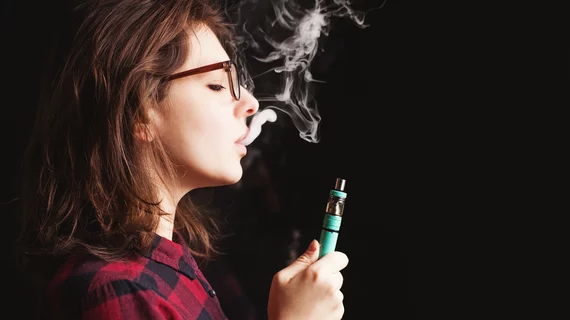8 in 10 young adults feel safe vaping despite EVALI outbreak
Seventy-one percent of young adults who use e-cigarettes believe it’s an unhealthy habit, according to a report from health data management firm Harmony Healthcare IT (HHIT)—but nearly 80% say they still feel safe vaping.
That’s despite the fact that EVALI—e-cigarette or vaping product use-associated lung injury—was dubbed a national epidemic in the U.S. more than a year ago. By January 2020 EVALI had claimed the lives of 57 people, all of whom reported using either nicotine- or THC-containing vaping products.
For its analysis, Harmony Healthcare surveyed 1,800 Americans between the ages of 18 and 38 who admitted to actively using vaping products. The majority of young adults reported using nicotine products (41%), though cannabis products were also popular (30%) and many people used a combination of both (27%).
One vaping cartridge, or pod, is similar in risk to two or three packs of cigarettes, HHIT said, and on average, respondents said they finished a cannabis or nicotine pod in two days or less. Cannabis products were a little pricier than their nicotine counterparts, with users spending an average of $97 per month on THC-containing vaping products and an average of $55 per month on nicotine products.
Seventy-seven percent of people surveyed said they believed vaping was healthier than smoking cigarettes, though several studies have published evidence to the contrary. Another 60% said vaping was healthier than drinking alcohol, and 39% said it was healthier than smoking marijuana.
The majority of respondents—79%—said they felt “safe” vaping, though 71% admitted they thought it was unhealthy. Fifty-nine percent said they were concerned about recent EVALI cases and deaths, prompting around half of the pool to reduce the amount they vaped and 56% to considering quitting altogether.
Thirty-six percent of young adults said that if they knew someone who became ill from vaping, they’d continue to use e-cigarettes. The remaining 64% said they’d stop.
Around a quarter of participants said they followed vaping brands and “influencers” on social media, though 60% said vaping brands weren’t doing enough to prevent EVALI and 33% said social media accounts promoting vaping should be banned.
“Despite the conversation and uncertainty around who’s to blame for the vaping illness outbreak, it’s clear that more research and education are needed, especially among young vaping users,” HHIT’s report reads. “Nearly 80% of survey respondents vastly underestimated the number of vaping illnesses and injury cases that have been reported, believing that less than 500 cases had been cited—a number in stark contrast to the actual number of 1,888. Until more research is conducted around vaping and vaping-related illnesses, it seems that a combination of prevention and education are currently the best tools to help curb these illnesses and injuries.”

